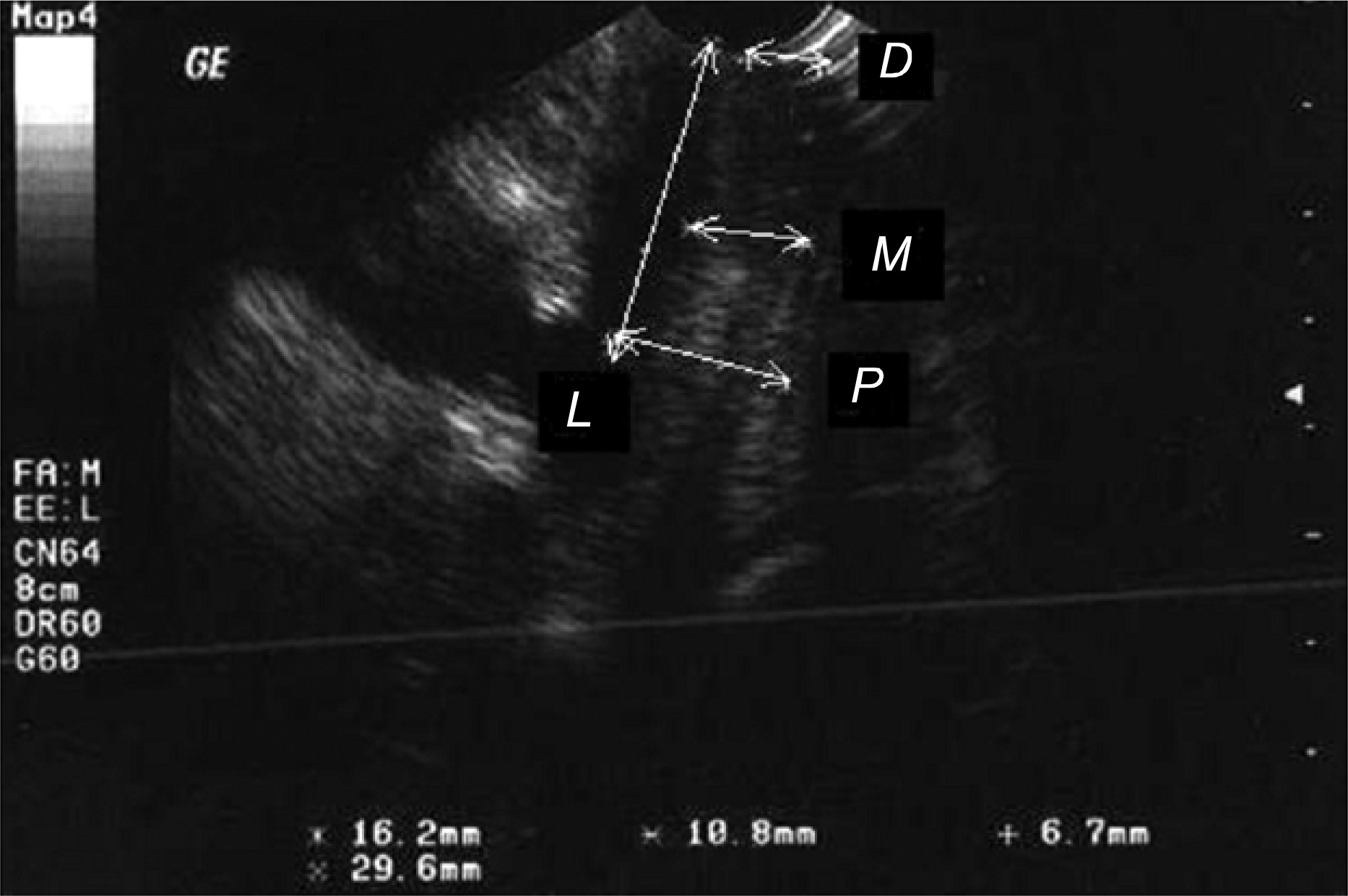Abstract
Purpose
Few studies are available on the role of female urethral length (UL) and anterior vaginal wall thickness (AVWT) in stress urinary incontinence (SUI). The aim of this study was to evaluate the usefulness of characterization of female UL and AVWT associated with SUI.
Materials and Methods
Between May 2006 and October 2006, a total of 53 women with or without SUI were included in this study. Twenty-three women with SUI and 30 healthy volunteers serving as controls underwent transvaginal ultrasound with use of a 7.5MHz transrectal probe. Measurement comprised UL and three portions of AVWT classified as proximal, middle, and distal according to the location against the urethra.
Results
The women’s median age was 51.1 (range: 30-73) years. The UL (mm, mean±SD) was significantly shorter in women with SUI than in women without SUI (28.7±2.8 vs 31.2±4.5, respectively, p=0.02). The AVWT of women with SUI (mm, mean±SD) was 16.2±2.8 in the proximal, 10.7±1.9 in the middle, and 9.3±2.0 in the distal portion, and those of women without SUI were 16.8±3.2, 10.1±1.8, and 6.9±1.3, respectively. Distal AVWT was significantly thicker in women with SUI than in women without SUI (p=0.01). There were no significant differences in AVWT or UL between pre- and postmenopausal women. A significant positive correlation was found between advancing in age and decrease in UL (p=0.03). Body mass index and parity showed no correlation with UL or any AVWT (p>0.05).
REFERENCES
1.Seo JB., Lee JZ. The epidemiologic study of the urinary incontinence in community-dwelling women over 50 years old. Korean J Urol. 1999. 40:1525–30.
2.Elving LB., Foldspang A., Lam GW., Mommsen S. Descriptive epidemiology of urinary incontinence in 3,100 women age 30-59. Scand J Urol Nephrol. 1989. 125(Suppl):37–43.
3.Hodgkison CP., Doub HP., Kelly WT. Urethrocystograms: metallic bead chain technique. Clin Obstet Gynecol. 1958. 1:668–77.
4.White RD., McQuown D., McCarthy TA., Ostergard DR. Realtime ultrasonography in the evaluation of urinary stress incontinence. Am J Obstet Gynecol. 1980. 138:235–7.

5.Keane DP., O'Sullivan S. Urinary incontinence: anatomy, physiology and pathophysiology. Baillieres Best Pract Res Clin Obstet Gynaecol. 2000. 14:207–26.

6.Kim JS., Lee T., Suh JK. The correlation between urethral hypermobility and intrinsic sphincter deficiency in stress urinary incontinence observed by videourodynamic study. Korean J Urol. 2000. 41:1358–64.
7.Kayigil O., Iftekhar Ahmed S., Metin A. The coexistence of intrinsic sphincter deficiency with type II stress incontinence. J Urol. 1999. 162:1365–6.

8.Kreder KJ., Austin JC. Treatment of stress urinary incontinence in women with urethral hypermobility and intrinsic sphincter deficiency. J Urol. 1996. 156:1995–8.

9.MeGuire EJ., Fitzpatrick CC., Wan J., Bloom D., Sanvordenker J., Ritchey M, et al. Clinical assessment of urethral sphincter function. J Urol. 1993. 150:1452–4.
10.Quinn MJ., Beynon J., Mortensen NN., Smith PJ. Vaginal endosonography in the post-operative assessment of colposuspension. Br J Urol. 1989. 63:295–300.

11.Beck RP., Hsu N. Relationship of urethral length and anterior wall relaxation to urinary stress incontinence. Am J Obstet Gynecol. 1964. 89:738–41.

12.Spence HM., Duckett JW Jr. Diverticulum of the female urethra: clinical aspects and presentation of a simple operative technique for cure. J Urol. 1970. 104:432–7.
13.Koo JM., Lee TY. Characteristic changes of cough urethral pressure profile in stress urinary incontinence. Korean J Urol. 1994. 35:665–70.
14.Harris TA., Bent AE. Genital prolapse with and without urinary incontinence. J Reprod Med. 1990. 35:792–81.
15.Stein JP., Stenzl A., Esrig D., Freeman JA., Boyd SD., Lieskovsky G, et al. Lower urinary tract reconstruction following cystectomy in women using the Kock ileal reservoir with bilateral ureteroileal urethrostomy: initial clinical experience. J Urol. 1994. 152:1404–8.

16.Stenzl A., Colleselli K., Bartsch G. Update of urethra-sparing approaches in cystectomy in women. World J Urol. 1997. 15.

17.Schaer GN., Perucchini D., Munz E., Peschers U., Koechli OR., Delancey JO. Sonographic evaluation of the bladder neck in continent and stress-incontinent women. Obstet Gynecol. 1999. 93:412–6.

18.Colleselli K., Stenzl A., Eder R., Strasser H., Poisel S., Bartsch G. The female urethral sphincter: a morphological and topographical study. J Urol. 1998. 160:49–54.

20.Raz S., Caine M. Adrenergic receptors in the female canine urethra. Invest Urol. 1972. 9:319–23.
21.Tanagho EA., Meyers FH., Smith DR. Urethral resistance: its components and implications. 1. Smooth muscle component. Invest Urol. 1969. 7:136–49.
Fig. 1.
Urethral length and anterior vaginal wall thickness by transvaginal ultrasonography. L: urethral length, P: proximal anterior vaginal wall thickness, M: middle anterior vaginal wall thickness, D: distal anterior vaginal wall thickness.

Table 1.
Demographic characteristics of the patients by groups
Table 2.
Anterior vaginal wall thickness and urethral length in continent and incontinent women
| Anatomical components |
Mean±SD |
p-value | |
|---|---|---|---|
| SUI (n=23) | Healthy women (n=30) | ||
| AVWT | |||
| Proximal | 16.2±2.8 | 16.8±3.2 | 0.52 |
| Middle | 10.7±1.9 | 10.1±1.8 | 0.28 |
| Distal | 9.3±2.0 | 6.9±1.3 | 0.01* |
| UL | 28.7±2.8 | 31.2±4.5 | 0.02* |
Table 3.
Correlation between the anatomical components and personal indices
Table 4.
Anterior vaginal wall thickness and urethral length in premenopausal and postmenopausal women




 PDF
PDF ePub
ePub Citation
Citation Print
Print


 XML Download
XML Download